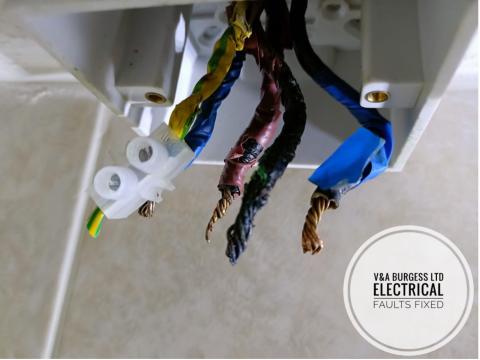
Table of Contents
- Why would half a plug socket stop working?
- Why would only one plug socket stop working?
- Why would two plug sockets stop working?
- How do you fix a plug socket that has no power?
- Why do electrical plug sockets fail?
- How many electrical items can run off one plug socket?
- Why are my sockets not working but the RCD has not tripped?
- Summary
May 2024
If you find that you have ONE SIDE OF THE PLUG SOCKET IS NOT WORKING there could be a minor issue or a more serious issue with the socket or the wiring behind it. When one side of a socket outlet fails then the outlet should be replaced as soon as possible.
Back to top1) Why would half a plug socket stop working?
The plug socket could be melted on one side or the plug socket could be burnt out on one side through overheating, overloading or wear and tear.
Plug sockets in the UK are only designed to be loaded with 13 amps of electrical current or approximately 3kw. This means that two large power-hungry appliances such as a washing machine and dryer could easily overload a plug socket. One of the most common causes for a tumble dryer socket to fail is the combination of that appliance and another that has been used in the same plug socket simultaneously.
Another possible cause for half of a double plug socket to fail is that the shutter mechanism has jammed. The UK plug socket is one of the safest in the world due to stringent BS1363 standards. Amongst these standards is the requirement for shutters on the Line and Neutral terminals that will not open until the earth pin is inserted. As a result, this moving part of the plug socket can wear out and jam causing that side of the plug socket to fail as a result.
Back to top2) Why would only one plug socket stop working?
If you find that one electrical outlet is not working properly then it could be as a result of loose wires, a blown fuse, a tripped breaker or simply a faulty outlet.
One plug socket failing can happen for many reasons so we will go through some of them here and the possible fixes.
2.1) Loose Wires
Loose wiring in the back of a plug socket can mean that it no longer works. It may or may not affect the rest of the socket outlets on the electrical circuit or it may simply just affect that single outlet. If you find that ONE SIDE OF THE PLUG SOCKET IS NOT WORKING then it is definitely NOT loose wires.
Loose wiring would affect BOTH sides of the plug socket.
Loose wiring can cause fires so it is important that the connections are correctly tightened. This is not a DIY job and only an electrician should check the connections are correctly tightened on electrical equipment. Certain electrical equipment has specific torque requirements that must be met in order to ensure safety.
2.2) Blown Fuse
Where sockets have been extended or added on, an electrician may have installed a fuse to prevent overload in the future. If you find that one socket outlet or more have stopped working then there could be an issue.
This WON’T affect ONE SIDE of a socket outlet but will certainly be a potential cause for one or more entire outlets failing.
2.3) RCD tripped / Tripped Breaker
Ground Fault Circuit Interrupter or RCD has tripped. These devices are common where a plug socket outlet electrical circuit has been extended to feed some conservatory sockets or sockets in an extension. Whilst not ideal and currently not recommended under the wiring regulations, it was common in the past to tag on to an existing circuit rather than running a new electrical circuit from the fuse box.
Check for a device nearby the failed socket with a reset button or RCD written on the front of the face of the accessory. The electrical accessory is normally the size of a single socket outlet. If you can’t find one of these devices then check the consumer unit, fuse box or electrical panel to see if there is a tripped circuit breaker.
2.4) Faulty Outlet
Sometimes a wall socket can simply just go faulty. They are not designed to last forever and old outlets will eventually fail through use, wear and tear or corrosion due to moisture and age.
A double socket is just as likely to fail as a single socket outlet, all the possible causes are the same for both but a single socket outlet is possibly less likely to be overloaded as only one appliance can be plugged in unless an extension lead is used.
If you are unsure what is safe to plug into an extension lead then its best to check the calculator.
Back to top3) Why would two plug sockets stop working?
There are a few reasons why TWO plug sockets might stop working but perhaps the most common reasons would be:
- Failed connections
- Burnt out Junction Box
- Loose Wiring somewhere
- Short Circuit
- Circuit Breaker Trips
3.1) Failed Connections
Where connections have failed, it may affect one or more plug sockets depending on how the electrician wired the electrical circuit. Connections can fail if they have not been maintained, have been poorly installed or overloaded.
3.2) Burnt out junction box
A burnt-out junction box may also occur if the junction box was not rated for the amperage (amount of electrical current or load) that has been pulled through it. These can also burn out as a result of wiring not being adequately tightened. We can see from the photo that this burnt-out junction box was a real fire risk. It was installed in the loft with lots of timber and other materials surrounding it, plenty of fuel for a potential fire.
3.3) Loose wiring somewhere
Loose wires cause fires. It’s a fact that loose wiring will cause electrical wiring and connections to overheat. Electricity needs nice tight low resistance joints for electrical current to flow freely. Anything that impedes current flow causes heat to build up. Think of a traffic jam where 6 lanes get bottlenecked into one lane at road works. Things slow down and tempers can flare.
Loose wiring is something that a professional electrician can check for to an extent. It’s a good idea to have an electrical inspection carried out every ten years on your home and ESPECIALLY important if the property is older.
3.4) Short Circuit
What is a short circuit? A short circuit is a connection between Line and Neutral without a resistance in between. It leads to a massive electrical surge of fault current to flow which NEEDS to be disconnected immediately to prevent electrical fires from occurring.
A short circuit may have cause two socket outlets to fail but definitely WON’T cause an issue where ONE SIDE OF THE PLUG SOCKET IS NOT WORKING. If you have a short circuit then a fuse should blow in the fuse box or a circuit breaker should trip.
You may find that a fuse local to the plug sockets will blow first. This may be the case where socket circuits have been extended in the past to supply additional plug socket outlets.
3.5) Circuit Breaker Trips
Depending upon the type of trip switches that you have installed, these devices will trip for a variety of reasons. Their job is to disrupt the flow of electricity when there are a variety of different electrical faults.
A circuit breaker will disconnect the supply when there is a Line – Neutral or Line – Earth fault but there needs to be a sufficiently large fault for these devices to operate.
An RCD/GFCI/RCCB will trip when there is an earth fault meaning that there needs to be electrical current disappearing to earth from the circuit for these devices to trip off. One of these devices tripping could cause a problem meaning that a couple of sockets may no longer be working.
If you find that you have socket outlets working but nothing has tripped then read our article on this here.
Back to top4) How do you fix a plug socket that has no power?
There is often no safe way for a homeowner to tackle these repairs themselves. The best option to try and tackle a dead outlet is to check for any fuses that have blown or breakers that have tripped. If this is the case then you can try replacing the fuse or resetting the breaker.
Only do this once.
If the breaker trips again or the fuse blows again then there is an electrical problem and you will need an electrician to attend to investigate the cause. A professional electrician with the right test equipment, years of experience and knowledge can narrow down electrical issues reasonably quickly.
Back to top5) Why do electrical plug sockets fail?
Power outlets, internal parts of the circuit breaker panel, junction boxes and other electrical accessories can all fail with age. Whilst this is not the primary cause, it is a common reasons for electrical issues.
All electrical accessories are part manufactured from metals. These metals often contain moving parts which can wear away with use and develop high resistance connections. The metals can corrode, rust, and become less conductive to electricity.
All of these reasons can result in plug sockets failing. There is also the issue of moving parts contained within the plug sockets which can jam, break, and get blocked with dust and debris. The electrical system in our homes is full of moving parts that we don’t consider and all these moving parts are subject to eventual failure.
Back to top6) How many electrical items can run off one plug socket?
Our electrical needs in the modern day often exceed that of the capability of our electrical system. One plug socket can safely supply 13 amps of electrical current for a short period. The main issue is the BS1361 plug top fuse. This device can get very hot at 13 amps and cause failure to occur in plug sockets and plug tops if it is used for an extended period at 13 amps.
This will result in overheating, melting, damage to the plug top and damage to the plug socket outlet. It is vital that you take safety precautions when considering how many appliances to plug in to an extension lead or plug socket. Just because it is theoretically possible to connect ten appliances to one plug socket does not mean that the plug socket can safely supply that amount of electrical power.
7) Why are my sockets not working but the RCD has not tripped?
An RCD will trip for a variety of reasons but not necessarily for the following reasons:
- Bad wire connections / Loose Connections
- A small fire from overheated electrics
- Circuit Breaker Problems
- Blown Fuses
There may be a number of causes for the plug socket not working even though the RCD hasn’t tripped. Please do not investigate the cause yourself, it is likely that electrical danger exists and a licensed electrician should be called to check this out for you.
A qualified electrician can check for outlet problems in nearby outlets that aren’t working and also ensure that the breaker box hasn’t failed. They use a variety of special equipment in order to investigate plug socket outlet issues and will be able to carry out your electrical work safely without endangering anyone.
Back to top8) Summary
Whilst issues where ONE SIDE OF THE PLUG SOCKET IS NOT WORKING can be frustrating, there are often simple causes. Once the fuses and trip switches have been checked, the next step is to call a local electrician to attend to ensure that the larger issue can be looked at.
Electrical faults like this can be red flags that there are other issues in the wiring system so always ask for an electrical inspection if yours is overdue. Electrical experts can inspect your system and check for any defects that affect safety.
Don’t turn to an online community for DIY tips for your electrics, this is the equivalent of receiving an education from down the pub and there is simply not enough information freely available to ensure that the requirements of the wiring regulations are met.
Back to top












